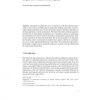84 search results - page 7 / 17 » Biologically Inspired Intelligent Robots Using Artificial Mu... |
CEC
2010
IEEE
13 years 8 months ago
2010
IEEE
The evolution of Artificial Intelligence has passed through many phases over the years, going from rigorous mathematical grounding to more intuitive bio-inspired approaches. Despit...
AR
2007
13 years 7 months ago
2007
—Researchers in robotics and artificial intelligence have often looked at biology as a source of inspiration for solving their problems. From the opposite perspective, neuroscie...
IWINAC
2009
Springer
14 years 1 months ago
2009
Springer
Manifold initiatives try to utilize the operational principles of organisms and brains to develop alternative, biologically inspired computing paradigms. This paper reviews key fea...
AGI
2011
12 years 11 months ago
2011
Abstract. Humans have the remarkable ability to generalize from binocular to monocular figure-ground segmentation of complex scenes. This is clearly evident anytime we look at a p...
NICSO
2010
Springer
14 years 2 months ago
2010
Springer
Subsumption architectures are a well-known model for behaviour-based robotic control. The overall behaviour is achieved by defining a hierarchy of increasingly sophisticated behav...

